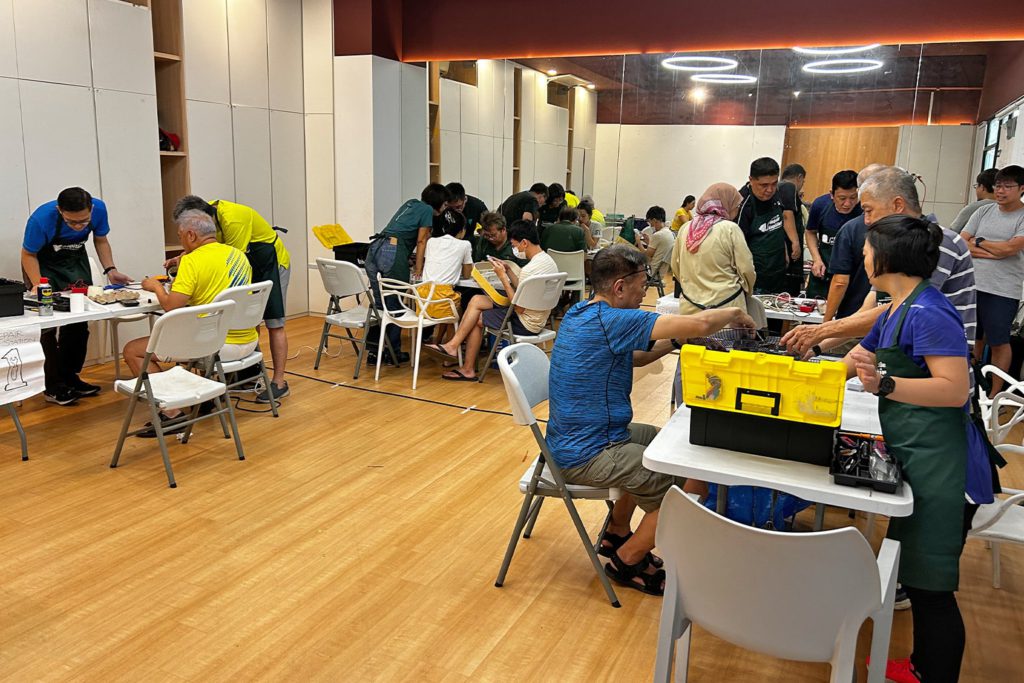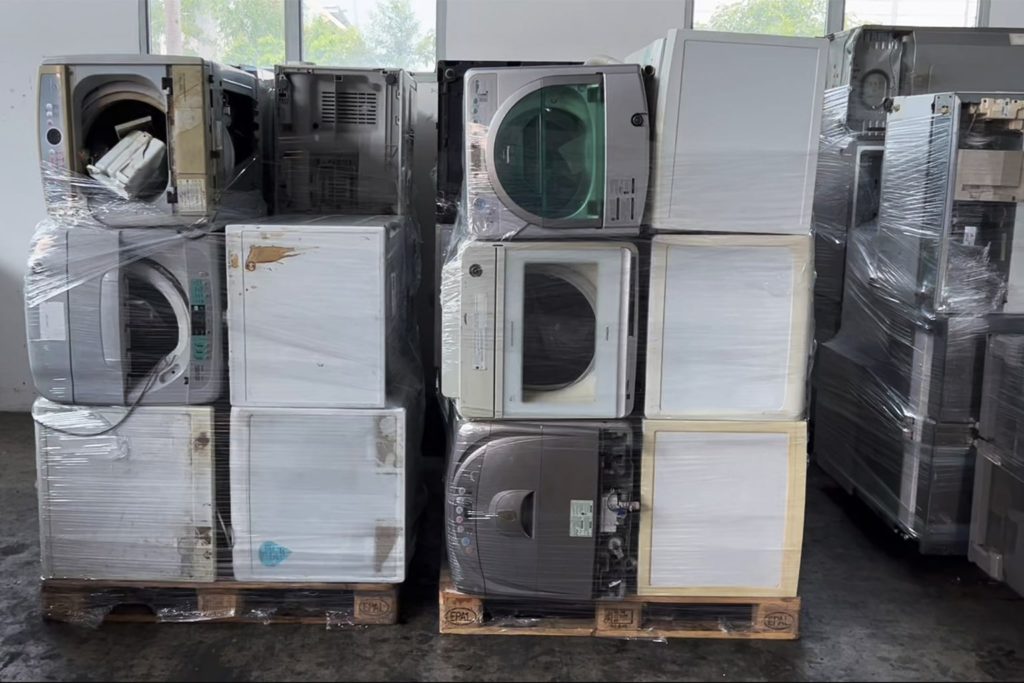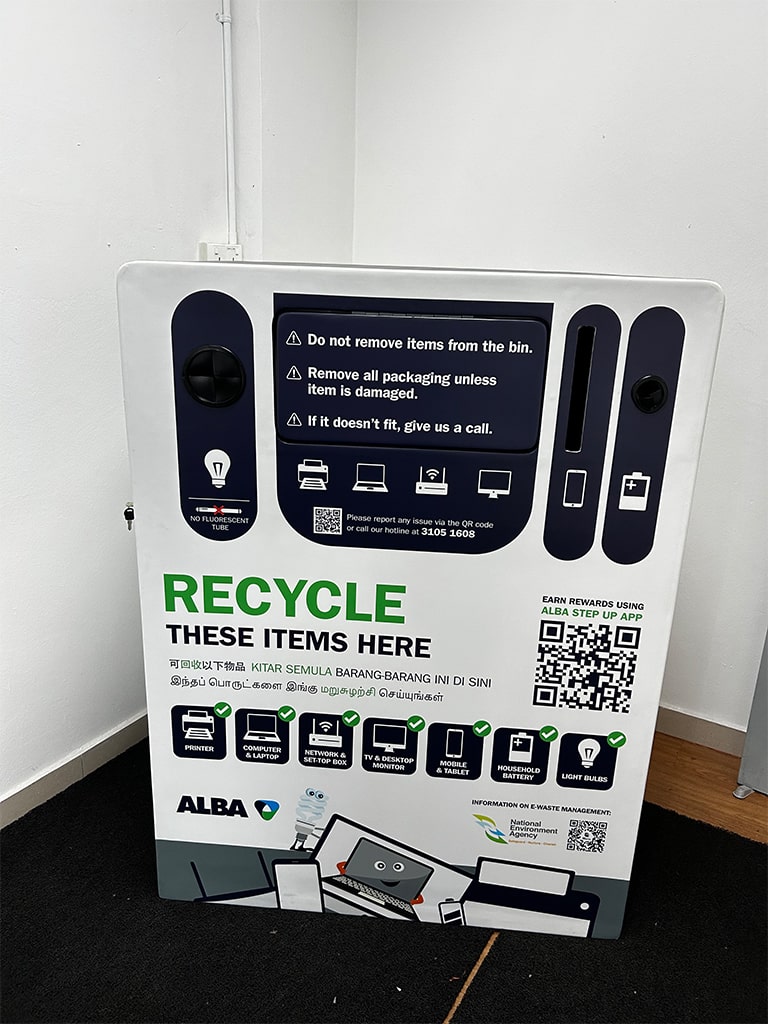- The disposal and recycling of electrical and electronic waste is a huge problem in land-starved Singapore, which generates an estimated 60,000 metric tons of e-waste annually.
- Innovative legislation enacted by Singapore’s government in 2019 puts the onus on producers to collect used electrical appliances and electronic goods and send them to sorting and recycling facilities.
- At the community level, a volunteer-driven initiative called Repair Kopitiam relies on an army of tech-savvy volunteers who work out of community centers to repair people’s old appliances and electronics.
- E-waste is the fastest-growing waste stream in the world—studies estimate e-waste generated annually will increase from 50 million metric tons today to 120 million by 2050, so lessons learned from Singapore’s groundbreaking law could guide other nations and communities around the globe to deal effectively with e-waste.
If you didn’t know better, you might think Edwin Beng is heading home after buying a new appliance. It’s a muggy Sunday morning in Singapore, and Beng, carrying a signature bright blue Ikea bag in one hand, steps off the street, descends into a building basement, and enters a corner room.
The vibe inside is cheery as Beng pulls a table fan from his bag. It’s far from new; in fact, he bought it three years ago, but it stopped working the previous week. Beng was about to throw it away when a neighbor told him about Repair Kopitiam. He decided to give the program a shot to see if it could bring the fan back to life.
Repair Kopitiam (kopitiam means coffeeshop in the Malay language) isn’t an official repair center. Rather, it’s an innovative program and weekly community gathering where volunteers help fellow Singaporeans repair and reuse their electrical and electronic goods. Started in 2014, the group consists of volunteers enthusiastic about repairing things who have been trained by other volunteers with more technical expertise.

On this day, a volunteer is focused on fixing a hair dryer. Another listens intently to a woman explaining the issues with a clock she bought in Hong Kong. Shuttling between each group is Danny Lim, overseeing the gathering.
“By repairing, we take an item for which carbon is already spent during manufacture, fix it for a lot less carbon, and then put it back [into service] so that it continues its useful life,” Lim, a mechanical engineer and administrator at Repair Kopitiam, tells Mongabay.
The ultimate aim of the initiative, Lim adds, is to train more volunteers all across the city-state until every neighborhood becomes self-sufficient when it comes to repairing electronic goods and electrical appliances. “We want to arm people with a capacity to understand things from the base so that they will naturally hunt for more stuff to fix rather than throw them away.”
In tech-obsessed Singapore, it’s an important mission.
A study released in 2018 by Singapore’s National Environment Agency found that the country produces 60,000 metric tons of electrical and electronic waste every year—a huge amount considering that Singapore is among the smallest countries in the world by area. Adding to the urgency of solving its e-waste woes, the island nation’s only landfill is expected to hit capacity in 2035 if the current rate of waste generation isn’t abated.

E-waste isn’t just a Singapore problem. The world’s obsession with technology has resulted in e-waste becoming the fastest-growing waste stream on Earth, with the former head of the United Nations Environment Programme describing the unfolding crisis as a “tsunami of e-waste.” Approximately 50 million metric tons of e-waste are produced globally every year, out of which only 20% is formally recycled, according to a report by the World Economic Forum. That report estimates that this total could more than double to 120 million metric tons by 2050 if no action is taken.
“E-waste is a silent kind of waste unlike plastic waste, which is in your face, and on beaches and in drainage systems,” Deepali Sinha Khetriwal tells Mongabay in a video interview. A former research associate at United Nations University and founder of an e-waste recycling company in India, Khetriwal says that, “The pollution starts when you throw it into a landfill.”
There, defunct computers, video game consoles, cellphones, batteries and household electrical appliances, along with other e-waste, begin to decay and react with everything else, with various materials, including harmful substances, gradually leaching out and polluting the environment. According to a 2021 study published in The Lancet Planetary Health, e-waste contains several toxic chemicals such as lead, cadmium, mercury and nickel, as well as organic compounds such as flame retardants and chlorofluorocarbons, exposure to which adversely affects the environment and human health.
Khetriwal echoes calls from researchers around the world who are urging the rapid replacement of humanity’s long-established “take-make-waste” linear economy model (the source of many of our planet’s environmental problems), with a “reduce-reuse-recycle” circular economy model, which will ultimately generate zero waste and drastically reduce environmental harm.
Today, in Singapore, innovative attempts are being made to adopt this circular model.
Pursuing that goal, the government in 2019 enacted the Resource Sustainability Act, a piece of legislation that targets three waste streams, one of which is e-waste. As part of this landmark legislation, the government established an extended producer responsibility (EPR) framework, under which the manufacturers of electrical and electronic goods are required to handle the costs and logistics related to the collection and recycling of their products’ e-waste.
The EPR framework extends the time frame of a producer’s responsibility to include the full life cycle of the product, as opposed to the way the linear economy model works, where the producer’s responsibility ends once the product is sold—with the consumer, taxpayers and government left to pay for disposal. Not surprisingly, EPR is an approach that corporations the world over have resisted as they try to minimize their costs and maximize their profits.
Singapore’s legislation requires producers with outlets bigger than 300 square meters (3,220 square feet) to set up e-waste collection points inside their facilities. It also requires companies that manufacture electrical appliances and electronic goods to organize free collection of old goods from people who have requested pickup — a service that previously came with a fee.
To ensure compliance, Singapore’s government designated ALBA Group Asia, the regional branch of a German recycling company, as the program operator. The company is now responsible for not just keeping producers accountable, but also overseeing e-waste collection. Producers are required to hand over the waste they collect to ALBA, while the company also organizes collection drives and liaises with town councils to gather waste from across the nation. ALBA has also placed 600 e-waste bins in Singapore’s urban area, making it easy for people to dispose of their used waste.

Away from the urbanized area, ALBA has established a sorting facility as a central destination for all the waste collected from around the country. Here, workers wrap old refrigerators and washing machines in plaster wraps, before weighing them and moving them outside to a waiting truck. In another part of the building, containers are filled with sorted and classified old phones, laptops, lightbulbs, batteries and chargers. ALBA sends the sorted waste to recyclers in Singapore and abroad.
“There, they will dismantle the products, segregate [the parts] further and remove the plastics, scrap metals, printed circuit boards and whatnot [for reuse],” June See, public relations executive for ALBA Group Asia, tells Mongabay. “After that, [the waste] might be sent to a metals trader or to refineries overseas.”
According to See, the company collected 8,900 metric tons of e-waste between July 2021 and December 2022. Public awareness, she says, has increased from the start. “When we did community events earlier, the questions were on the lines of ‘What is this all about?’ ‘Is this even safe?’” she says. “Now, we get specific questions about collection points and the types of waste included.”
But the work isn’t without its challenges.
For one thing, people don’t always follow directions. So, ALBA personnel often have to spend time sorting out and removing packaging waste and other trash that people dispose of along with e-waste. “This creates a lot of pressure on manpower and resources,” See says.

Additionally, the 2019 law isn’t yet broad enough to cover all forms of e-waste. While large household appliances (such as televisions, washing machines and refrigerators), and old electronics (such as desktop computers, laptops, phones and batteries) are among the regulated e-waste, the law leaves out smaller household equipment like electric kettles and rice cookers, as well as items such as clocks and small medical equipment.
But of course, people still need to dispose of these unregulated items, for which streamlined recycling processes haven’t yet been set up. The sorting and disposal of this unregulated waste puts stress on ALBA facility resources. “Most people see all e-waste as e-waste, and that’s not wrong,” See says. “But because of how the legislation works, it gets a little complicated.”
See says she expects the law to be expanded to cover more forms of e-waste in future, which could alleviate that problem. Until then, community initiatives like Repair Kopitam aim to fill the gaps.
But that, too, has its own set of challenges. For instance, when the use of air fryers (currently listed as unregulated e-waste in Singapore) shot up during the COVID-19 pandemic, Repair Kopitiam volunteers had no clue how to dismantle and repair them. “Then a few of our veterans came together and figured it out. And, now we are fixing air fryers,” Danny Lim says. “It’s a learning process for us too.”
The learning experience provided by Singapore’s e-waste experiment, if disseminated to other nations, could help facilitate a move toward curbing the global e-waste problem.
Meanwhile, back at the neighborhood, Edwin Beng’s table fan, the one he was about to dispose of, is running again after a 20-minute fix. In fact, it wasn’t broken at all. Grease had accumulated inside, hindering its functioning. A quick cleaning made it almost as good as new.
Smiling from ear to ear, Beng places the fan back in his Ikea bag. As he prepares to go, he tells the volunteers how glad he is to have found his way to Repair Kopitiam. “If you can repair and recycle,” he says, “then why not?”
This article first appeared on Mongabay and was originally written by Abhishyant Kidangoor, a staff writer at Mongabay. It has been republished here under the Attribution-NoDerivatives 4.0 International (CC BY-ND 4.0) Creative Commons license.
